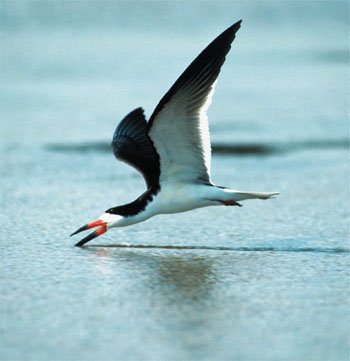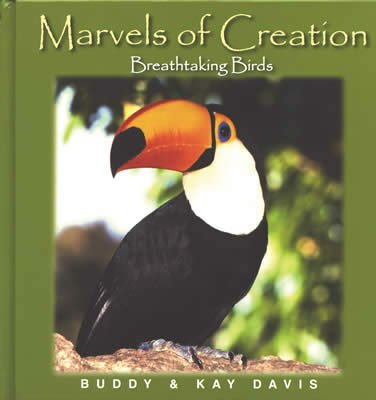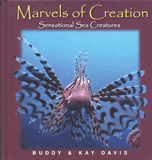Black Skimmer
Excerpt from Marvels of Creation: Breathtaking Birds
by Buddy Davis and Kay Davis on January 4, 2013Skimmers are nicknamed scissorbills because of the design of their beak.

Skimmers are nicknamed scissorbills because of the design of their beak. They live by large rivers, lakes, lagoons, estuaries, marshes, and the seacoast but do not venture out far to sea. The black skimmer prefers the inland waters of the tropical Pacific and Atlantic coasts of North America. It is the largest of the three skimmers. The other two are the African and Indian skimmer.
The wings of the black skimmer are long, narrow, and pointed and it has a forked tail. The webbed feet are at the end of short, reddish legs. The body is brownish-black above and white underneath. Males and females look alike, but females are smaller than males. A unique feature among these birds is the vertical cat-like pupil in the eye. The beak is black in front and red behind. Black skimmers sound something like a pack of hounds baying at a treed animal.
Most hunting is done in the evening. The special design of the skimmer allows it to hunt for food in a unique way. The lower mandible is longer than the upper, allowing the bird to fly inches above the water, “skimming” the surface, with the lower mandible cutting into the water. In this manner, it feeds on fish and other small aquatic creatures. Strong neck muscles help snap the prey out of the water. The bill has sharp edges near the base which keep the slippery fish from sliding out of the mouth.
Skimmers are sociable, nesting, feeding, and roosting in flocks. These birds nest in loose colonies with the nest consisting of a hollow depression in the sand. They will usually lay four or five buff black-spotted eggs, which are incubated by the female. Both parents feed the young hatchlings, but it’s not long before the chicks leave the nest. Hatchlings are camouflaged and nearly invisible as they crouch in the sand. The bills of the young are equal in length when they hatch so they can feed on the ground, picking up small pieces of food. As the feathers begin to grow, so does the lower half of the bill. At approximately six weeks of age, the young skimmers start to fly.
Black Skimmer
Charadriformes • Rynchopidae
Rynchops nigra
Length: 18 inches (45 cm)
Life Span: 12–15 years
Special Design
Feature: God designed the lower bill of the skimmer to grow longer than
the upper. This allows the skimmer to fly close to the water and funnel water
around the beak so it can catch aquatic life.
Did you know? Skimmers
can stay airborne close to the water without allowing their wings to drag in
the water.
Marvels of Creation: Breathtaking Birds
This spectacular book brings the world of feathered creatures alive in a unique and colorful way.
Browse Kids BookRecommended Resources
- © 2024 Answers in Genesis
- Privacy Policy
- Contact
- About




